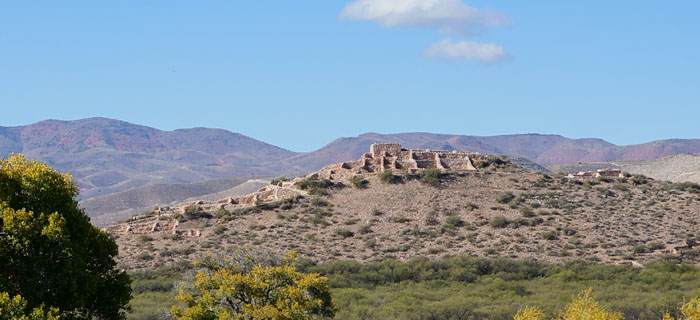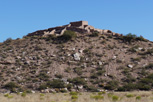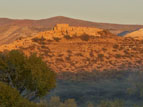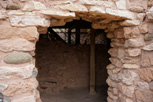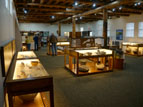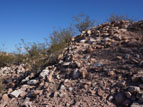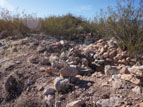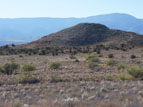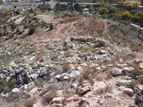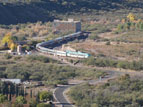From 1100 to about 1425 AD, the Verde Valley was occupied by a people called the Southern Sinagua--a name that means "Without Water" in Spanish. The Sinagua constructed a string of pueblos up and down the Verde River, forming a loosely knit polity called the Verde Confederacy (see below) that engaged in mutual trade and unified defense for over 300 years. The northern end of this chain of ancient pueblos is marked by three major sites, all located within a few miles of each other: Tuzigoot (90 to 100 rooms), Hatalacva (60 rooms), and the once-mighty Bridgeport (237 rooms). Bridgeport and Hatalacva now lie in ruins; but Tuzigoot was excavated in the thirties and subsequently reconstructed. It is now a National Monument, open to the public.
Tuzigoot is located atop a small hill in an oxbow of the Verde River, outside the old mining town of Clarksdale, Arizona. With an estimated 90 to 100 rooms, it is one of three major pueblos near the north end of the Verde River Valley.
Construction at Tuzigoot spanned over 300 years, from about 1100 to 1400 AD. The earliest construction consisted of a small number of rooms near the top of the hill, with new rooms added in an ad-hoc fashion as the population increased. At its peak in the late 1300s, the pueblo was 500 feet long, 100 feet wide, contained 86 ground floor rooms and 15 second story rooms, and probably housed as many as 230 people.
The name Tuzigoot is Apache for "Crooked Water". At one time the river flowed in a loop around the west side of Tuzigoot; but long before the arrival of man it changed its course, and now runs along the east side. The original riverbed to the west became a large, flat marsh (Tavasci Marsh), and was used by the Pueblo's inhabitants to grow crops of squash, corn and beans.
Tuzigoot was excavated in 1933-1934 by archaeologists Louis R. Caywood and Edward H. Spicer, aided in part by labor provided by the Federal Emergency Relief Agency's Civil Works Administration (CWA), an organization created during the Great Depression to provide employment for out-of-work Americans. Caywood and Spicer's report to the U.S. Department of the Interior, titled "Tuzigoot; The Excavation and Repair of a Ruin on the Verde River near Clarkdale, Arizona" (July, 1935), contains some fascinating details:
- During excavation, 429 sets of human remains were discovered. In most cases, these were found buried in the hillside with a few personal possessions, their heads covered with rush matting, and their bodies wrapped in cotton cloth. Many of these remains were reburied at the site after excavation was completed.
- Dedrochronolgy--the technique of tree ring dating--had just been developed by A. E. Douglass of the University of Arizona, and Caywood and Spicer attempted to apply this new method to date Tuzigoot's roof timbers. Unfortunately, they met with limited success. Much of the site had been burned near the time of abandonment, destroying many of its wooden roof beams. Also, most of the wood used in construction was sycamore and juniper, neither of which lend themselves to tree ring dating. In the end, only two dates were obtained, both from pinion logs from the same roof, which dated construction of that particular section to about 1200 AD. But as the authors lamented: "The two rooms which this single roof covered are obviously neither the earliest nor the latest constructed rooms in the pueblo. They were built at some intermediate period in the history of the village."
- Entrances to rooms were almost exclusively by means of hatchways through the roofs. Only five side entrances were found, and two of these had been completely sealed up sometime during the period of occupation of the pueblo.
- The interior walls were all covered by a red-colored mud plaster an inch or more in thickness. However: "As a rule the plaster coats were blackened with smoke, so that the interiors of rooms must have presented a very dark aspect indeed."
- During the excavation of Tuzigoot, Caywood and Spicer also partially excavated the nearby Hatalacva Pueblo. But no field notes or reports are known to exist.
According to a 1933 agreement between the United Verde Copper Company and the Yavapai County Chamber of Commerce, all artifacts recovered during Caywood and Spicer's excavation at Tuzigoot Pueblo were to be divided between the United Verde Copper Company, the Smoki Museum in Prescott, and the Arizona State Museum in Tucson, with first choice going to the United Verde Copper Company (which owned the land). Much of this has since been accounted for, and many of the artifacts that originally went to the United Verde Copper Company are now on display in the museum at the site.
Tuzigoot National Monument was established by Presidential Proclamation on July 25, 1939.
The Hatalacva Pueblo, with about 60 rooms, is located on a hilltop along the Verde River north of Tuzigoot. It was partially excavated by archaeologists Caywood and Spicer in the 1930s (see above), and the exposed portions of the site have been severely damaged by pot-hunters. In 1996 Hatalacva was acquired by the Archaeological Conservancy--a national non-profit preservation organization based in Santa Fe--from the Phelps Dodge mining company, with the goal of ensuring long-term protection and preservation. The excavation trenches have since been filled in and covered over in an attempt to stabilize the site, and the entire hilltop is now overgrown with brush. Although this makes it difficult to photograph, one can still clearly see the size and layout of the pueblo from surface indications. There are also many pot sherds present, including some decorated pieces imported from other parts of Arizona.
Hatalacva is off limits to visitors, except with permission.
With between 200 and 300 rooms, Bridgeport was once one of the four largest pueblos in the entire Verde Confederacy. It also has the misfortune of being well known and easily accessible, located on public land next to the Verde River and a major highway. Consequently it is almost completely destroyed, with most of the walls dismantled down to their very foundations. The damage is so great that two women we encountered walking their dog through the rubble had no idea they were standing in one of the largest fourteenth-century pueblos in Arizona. It is only when one notices that the stones covering the hilltop are all of about the same human-transportable size that the scope of the original structure becomes clear.
Bridgeport Pueblo serves as a cautionary example of what happens when an archeological site becomes too well known. In this age of the Internet, Google Maps and hand-held GPS, it will be interesting to see if this is the fate awaiting all unprotected sites in Arizona.
The Verde River is a rare thing in Arizona: a large, permanent source of water. Spanning over 100 miles, the Verde provides a natural corridor and trade route between the northern plateau and the southern deserts, and has been inhabited at different times by several different cultures.
There is evidence of Paleo-Indian hunter-gatherers in some parts of Arizona that date as far back as ten thousand years. In the Verde Valley, there is direct archeological evidence of human habitation dating back only about two thousand years, although it is almost certain that people were there long before that.
From about 600 to 1100 AD the region was occupied by a people with ties to the Hohokam, a major culture centered around present-day Phoenix. This period is marked by single-room pit-houses and some smaller cliff dwellings. Around 1100 AD the region began to see an influx of Sinagua from the north. All of the large, multi-room complexes in the Verde Valley date from that time or later. By AD 1300, there were over 50 major pueblos and hundreds of smaller ones dotted up and down the Verde. These, along with some additional pueblo clusters to the west along the Agua Fria River atop Perry Mesa, and to the east along Rye Creek, constitute what archaeologists refer to as the Verde Confederacy.
The four largest of these pueblos comprised between 166 and 300 rooms each, and may have housed as many as 800 people. Equally spaced about 30 miles apart along the Verde and surrounded by clusters of smaller pueblos, these were major political, economic, and probably military powers. Bridgeport Pueblo was the northernmost of these major power centers. The others were, from north to south: Mindeleff's Cavates near Camp Verde; Polles Mesa at the junction of the Verde and East Verde rivers; and Mercer, submerged under what is now Horseshoe Lake.
All of these sites were continuously inhabited by the Sinagua for approximately three hundred years--a period longer than the United States has existed. They were all abandoned in the early 1400s, about the time the Yavapais and the Tonto Apaches migrated in from the north, and more than a hundred years before the arrival of the first Europeans. For reasons that have never been fully understood, this period marks the collapse of all the major civilizations in the southwest, including the Sinagua, Salado, Hohokam, Mogollon, and Anasazi. Possible explanations include an extended period of drought; disease; the exhaustion of farmlands due to non-sustainable agricultural techniques; and war.
Tuzigoot is located near the town of Clarkdale, which was founded in 1912 by US Senator William A Clark to house miners for the Verde Copper Company, which Clark owned. The Verde River around Tuzigoot was used as a dump site for tailings and slag from the mines, with the result that heavy metals--including cadmium, copper, lead, mercury, silver and zinc--have leached into the river and aquifer. Mining has now ceased, and the area is a U.S. Government Superfund site.
The United Verde Copper Company merged with Phelps Dodge, which was acquired by Freeport-McMoRan Copper & Gold in 2007. Freeport-McMoRan is the largest publicly traded copper producer in the world. Cleanup operations commenced in 2007, with 129 acres of the orange tailings around Tuzigoot being covered over with a few feet of natural soil and replanted with native plants and grasses.
The black slag pile in Photo 17 is about a mile upstream from Tuzigoot. It contains about 3 million tons of smelter slag, and covers an area the size of 15 football fields.
The Verde Canyon Railroad (Photo 18) is a tourist attraction that runs out of Clarkdale along a rail line originally constructed to support mining operations. The tour runs from Clarkdale to the small "ghost ranch" of Perkinsville and back along 38 miles of track, and takes about four hours round-trip. Although the narration provided during the tour does not mention it, there are some small cliff dwellings visible in the canyon walls near the beginning of the tour.
The following links may be of interest to anyone visiting Tuzigoot or Clarkdale:
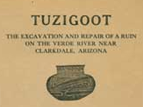
Caywood-Spicer Report
"TUZIGOOT-The Excavation and Repair of a Ruin on the Verde River near Clarkdale, Arizona." By Louis R. Caywood and Edward H. Spicer for the U.S. Department of the Interior. (1935)
